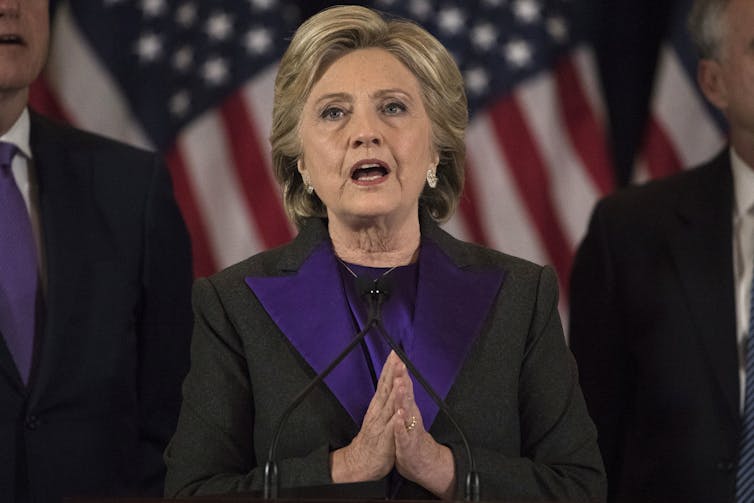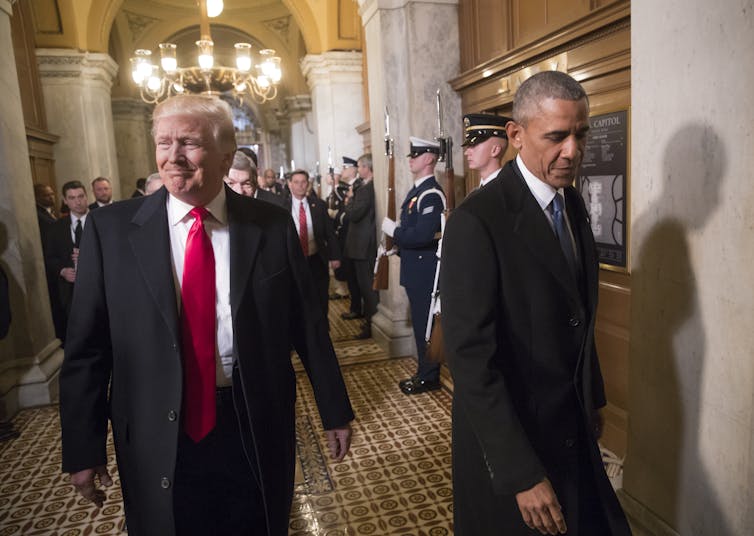
What hasn’t been clear, however, is how much of an impact – if any – these “fake news” items had on the outcome of the election. To our knowledge, there have been no empirical studies that have systematically assessed the extent to which believing fake news stories influenced voting decisions in 2016. So, we set out to do one.
We are scholars associated with the Comparative National Elections Project, which is coordinated at The Ohio State University. In December 2016, we commissioned YouGov to conduct a nationwide post-election survey. Our study concludes that fake news most likely did have a substantial impact on the voting decisions of a strategically important set of voters.
⏩ Here’s what we learned.
Our research questions
The survey had 1,600 respondents. We focus our analysis on the 2016 electoral behavior of 585 respondents who had voted for Barack Obama in 2012. This strategic subset of voters was selected for two reasons.
- First, restricting our analysis to former Obama supporters allowed us to weed out those respondents who were hostile to all Democratic candidates.
- Second, if Hillary Clinton had retained the support of Obama voters, she would have most likely won the 2016 election. Instead, just 77 percent of Obama voters supported Clinton. Our survey data show that 10 percent of these former Obama voters cast ballots for Trump in 2016, 4 percent switched to minor parties and 8 percent did not vote.
Study methodology and results
Our survey asked 281 questions, including three false statements best characterized as fake news – two negative statements about Hillary Clinton and one positive statement about Donald Trump. All three were widely disseminated through social media and spread by mainstream and partisan news outlets.
- The first is that “Hillary Clinton is in very poor health due to a serious illness.” Twenty-five percent of all survey respondents believed that this was “definitely true” or “probably true,” as did 12 percent of our former Obama supporters.
- The second is a statement that asked our respondents if they believed that “During her time as U.S. secretary of state, Hillary Clinton approved weapon sales to Islamic jihadists, including ISIS.” Thirty-five percent of our national sample believed that Clinton had sold weapons to the Islamic State, as did 20 percent of former Obama voters.
- Finally, the third is a statement that “Pope Francis endorsed Donald Trump for president prior to the election.” About 10 percent of our national sample and 8 percent of Obama supporters thought this statement was true.
2016 support for Hillary Clinton among 2012 Obama voters
The column on the left shows the number of fake news statements rated 'probably' or 'definitely' true by 2012 Obama voters. The solid bar shows what percentage of the respondents answering that way voted for Hillary Clinton.
 |
The Conversation CC-BY-ND
|
⏩ We also explored a number of other possible explanations for these voters’ defections.
The Clinton campaign heavily emphasized gender issues in an attempt to mobilize female voters. Could this have alienated men to the extent that they abandoned their prior support for the Democratic presidential candidate? Our data provide no support for such a claim. An identical 23 percent of both male and female respondents who had voted for Obama in 2012 defected from the Democratic ticket.
Did the lack of an African-American presidential candidate lead black voters to waiver in their commitment to the Democratic candidate? No. Indeed, fewer African-American voters (20 percent) defected from Clinton than did white voters (23 percent).
Age is weakly related to defection from Clinton. While 20 percent of voters over 35 abandoned the Democratic ticket in 2016, 30 percent of younger voters did so.
Education is also weakly associated with defection. Among college-educated former Obama voters, just 16 percent did not vote for Clinton, but the percentage almost doubled to 27 percent defecting for those with lower educational attainment.
More overtly political variables had a stronger impact. Half of those who placed themselves near the conservative end of the ideological scale defected from the Democratic candidate, while only 14 percent of those on the left did so.
Similarly, dissatisfaction with the condition of the economy also had an impact: Just 12 percent of those who thought that the economic situation at the time of the survey was “good” or “very good” abandoned Hillary Clinton, while 39 percent who regarded the economy as “poor” or “very poor” at the time of the survey defected from the Democratic ticket.
Party identification exerted a stronger influence. Among the former Obama voters who identified themselves as Democrats, 7 percent did not vote for Clinton. This rose to 40 percent among independents and to 68 percent among those who identified with the Republican, Libertarian or Green parties.
Controlling for alternative explanations
So do all of these alternative factors mean it’s impossible to measure the unique impact of belief in fake news on the vote in 2016? Actually social science offers us a way. Multiple regression analysis is a tool that allows researchers to account for many different factors influencing behavior, in this case defecting from the Democratic ticket in 2016.
We used this tool to estimate the joint impact on the vote of all of these alternative explanatory factors. The first equation we ran included gender, race, age, education, ideological orientation, dissatisfaction with the condition of the economy and party identification. All together, these variables “explained” 38 percent of the likelihood of defection.
We then added the fake news items to the equation to measure their impact. The three fake news items explained an additional 14 percent of the likelihood of Obama voters defecting after the influence of all of the other variables had been taken into consideration.
We also added one more compelling element to our study. Using “feeling thermometers,” we measured how much each respondent liked or disliked Hillary Clinton and Donald Trump. If defection of Obama voters was only due to disliking Hillary Clinton or liking Donald Trump, then the introduction of this thermometer variable into the equation should make the link with fake news disappear.
Though how people felt about Clinton and Trump did somewhat reduce the strength of the relationship between fake news and defection, it did not eliminate it. Belief in fake news remained a significant predictor of defecting from Clinton. In sum, even after the impact of all of these other factors is taken into consideration, former Obama voters who believed one or more of these fake news stories were 3.3 times more likely to defect from the Democratic ticket in 2016 than those who did not believe any of these false claims.
About Today's Contributors:
Richard Gunther, Professor Emeritus of Political Science, The Ohio State University; Erik C. Nisbet, Associate Professor of Communication, Political Science, and Environmental Policy and Faculty Associate with the Mershon Center for International Security Studies, The Ohio State University, and Paul Beck, Professor Emeritus of Political Science, The Ohio State University
This article was originally published on The Conversation.
More "Fake News" Related Stories:
 |
| Fake News Invasion (via LoupDargent.info) |
- 'Trust Us, We're Lying': Eurozine And Cultural Journals From Across Europe Take A Closer Look At The Power Of 'Post-Truth' In A New Series Of Online Articles And Debates
- There's an Insidious Strategy Behind Donald Trump's Retweets
- Why 'Judeo-Christian Values' Are A Dog-Whistle Myth Peddled By The Far Right
- 14 Year Fox News Contributor Tobin Smith and Filmmaker Jen Senko Launch "FIGHT BACK AGAINST FOX NEWS" Crowdfunding Campaign to Publish Book "Fear & UnBalanced" & Distribute "The Brainwashing of My Dad" Documentary
- National Press Club Examines 2016 Russian Election Hacking at a Headliners Book Rap Featuring Donna Brazile on December 12th
More Donald Trump Related Stories:



















